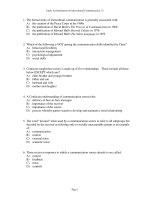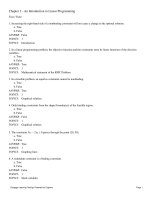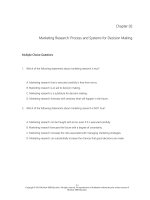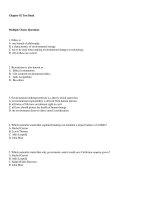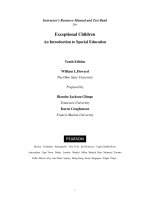An introduction to physical science 14th edition shipman test bank
Bạn đang xem bản rút gọn của tài liệu. Xem và tải ngay bản đầy đủ của tài liệu tại đây (309.16 KB, 16 trang )
1. Which one of the following is not an area of physics?
A) Mechanics
B) Optics
C) Algebra
D) Acoustics
2. Motion necessarily involves
A) a change in velocity.
B) a change in speed.
C) a change in direction.
D) a change in position.
E) all of these
3. The magnitude of a displacement is ______________ the magnitude of the distance
traveled.
A) always unequal to
B) less than or equal to
C) always equal to
D) greater than or equal to
E) none of these; the two cannot be compared.
4. Displacement divided by time gives
A) average acceleration.
B) average velocity.
C) average speed.
D) average distance.
5. Average speed multiplied by time gives
A) average acceleration.
B) displacement.
C) instantaneous speed.
D) distance.
6. Distance covered per unit of time is called
A) speed.
B) acceleration.
C) velocity.
D) displacement.
Page 1
7. The straight-line distance and direction between two points are, together, called
A) velocity.
B) displacement.
C) distance.
D) acceleration.
8. The magnitudes of two horizontal displacements are 1 m and 9 m, respectively. Given
that the vectors may be in either the plus or the minus direction, they cannot be added
together to give a total displacement of
A) 10 m.
B) –8 m.
C) 8 m.
D) 9 m.
E) 7 m.
9. A speedometer indicates ______________ if the automobile is traveling forward.
A) instantaneous acceleration
B) instantaneous speed
C) instantaneous velocity
D) average speed
E) average acceleration
10. If an object moves with constant velocity,
A) its speed is constant.
B) its direction is constant.
C) its average speed is constant.
D) its distance traveled per unit time is constant.
E) all of these
11. If the instantaneous velocity of an object is constant, then so is its
A) velocity.
B) distance.
C) acceleration.
D) displacement.
12. The rate at which an object's velocity changes with time is called its
A) instantaneous velocity.
B) motion.
C) speed.
D) acceleration.
Page 2
13. An automobile's acceleration may be changed by using the
A) windshield wipers.
B) steering wheel.
C) radio.
D) horn.
14. An automobile's acceleration cannot be changed by using the
A) gas pedal.
B) brake pedal.
C) steering wheel.
D) stick shift.
E) turn signal.
15. An acceleration may result from
A) a change in speed.
B) a change in direction.
C) a change in both speed and direction.
D) all of these
16. For which of the following is the acceleration constant?
A) Nonuniform speed
B) Free fall
C) Uniform circular motion
D) None of these
17. Velocity is similar to speed, but a ________ is also involved in velocity.
A) acceleration
B) direction
C) position
D) scalar
18. Which one of the following is true for deceleration?
A) The acceleration is in the direction opposite the motion.
B) The acceleration is zero.
C) The acceleration is necessarily negative.
D) The velocity remains constant.
Page 3
19. The distance traveled by an automobile moving at a constant velocity is
A) directly proportional to the time.
B) directly proportional to the time squared.
C) inversely proportional to the time squared.
D) inversely proportional to the time.
E) none of these
20. An object that is moving in a linear path with an acceleration in the direction opposite to
the motion has a(n) ______________ velocity.
A) constant
B) increasing
C) decreasing
D) none of these
21. An object that is moving in a linear path with an acceleration at a right angle to the
motion has a(n) ______________ velocity.
A) changing
B) increasing
C) decreasing
D) constant
22. An object that is moving in a linear path with an acceleration in the direction of motion
has a(n) ______________ velocity.
A) constant
B) increasing
C) decreasing
D) none of these
23. As a block slides down a 40° frictionless incline, its acceleration
A) decreases with distance.
B) remains constant.
C) is greatest at the bottom of the incline.
D) is greatest at the top of the incline.
24. Which of the following is a possible unit of acceleration?
A) m/s2
B) m s
C) m2/s
D) m/s
Page 4
25. If the magnitude of the velocity of an object increases, we may be sure that during the
time of this increase,
A) the object is accelerated.
B) the acceleration of the object increases.
C) the object is moving in a straight path.
D) the object is changing direction.
E) none of these
26. A freely falling object
A) has a uniformly increasing velocity.
B) is unaffected by gravity.
C) has a uniformly increasing acceleration.
D) has a uniformly increasing displacement.
27. An object in free fall has
A) a constant speed.
B) a constant velocity.
C) a velocity that changes 9.8 m/s each second.
D) an acceleration that depends on its mass.
28. An object with a mass of 8 kg is dropped and takes 5 s to hit the ground. Then another
object with a mass of 16 kg is dropped from the same point. How long does it take to hit
the ground?
A) 5 s
B) 10 s
C) 3 s
D) 25 s
E) 125 s
29. A car is moving down a freeway in a straight line at a constant rate of 24.0 m/s for 4.0 s.
Its acceleration is
A) 9.8 m/s2.
B) 9.8 m/s.
C) zero.
D) 24.0 m/s.
E) 6.0 m/s2.
Page 5
30. An object is dropped from a vertical distance of 31.7 m above the ground, and it takes
2.54 sec to fall that distance. A second identical object to launched from the same
height, with a horizontal velocity of 64.0 m/s. How long does the second object take to
fall the 31.7 m?
A) More than 2.54 sec
B) Almost 2.54 sec.
C) Less than 2.54 sec
D) Exactly 2.54 sec
E) Much less than 2.54 sec
31. A freely falling object has a constant acceleration of 9.8 m/s2. This means that
A) the object's displacement changes by 9.8 m every second squared.
B) the object's speed increases by 9.8 m/s each second.
C) the object's acceleration increases by 9.8 m/s2 each second.
D) the object travels 9.8 m each second.
32. An object that is moving with an acceleration different from zero will always have a(n)
______________ velocity.
A) changing
B) increasing
C) constant
D) decreasing
33. The distance traveled by a dropped object in free fall is directly proportional to
A) the time squared.
B) its weight.
C) its mass.
D) none of these.
34. Which of the following statements is not true?
A) Displacement has a direction and a magnitude.
B) Acceleration has a magnitude only.
C) Speed has a magnitude only.
D) Velocity has a magnitude and a direction.
35. All the following may be represented by vectors except
A) velocity.
B) acceleration.
C) speed.
D) displacement.
Page 6
36. An object in uniform circular motion has
A) constant acceleration.
B) variable radial distances.
C) constant velocity.
D) constant speed.
37. In the equation ac= v2/r for centripetal acceleration, the r stands for
A) diameter.
B) distance.
C) radius.
D) rate.
38. In the equation ac= v2/r for centripetal acceleration, the v stands for
A) volume.
B) very.
C) speed.
D) velociraptor.
39. An object travels in a circle of radius 10.0 m with a constant speed of 3.0 m/s. What is
the direction of its acceleration?
A) Toward the center of the circle
B) Normal to the plane of the circle
C) Insufficient data given for determination
D) Tangential to the circle
E) None of these
40. Centripetal means
A) center seeking
B) pulls outward
C) constant
D) fast
E) none of these
41. The magnitude of the acceleration of an object moving in a circle at constant speed is
A) variable.
B) directly proportional to the speed squared.
C) directly proportional to the speed.
D) directly proportional to the radius of the circle squared.
Page 7
42. The direction of the acceleration of an object moving in a circle at constant speed is
A) changing, but pointing in a predictable direction.
B) constant and pointing in only one direction.
C) constant and pointing in two directions.
D) none of these
43. The magnitude of the acceleration of an object moving in a circle at constant speed is
A) inversely proportional to the speed squared.
B) inversely proportional to the speed.
C) inversely proportional to the radius of the circle squared.
D) inversely proportional to the radius of the circle.
44. If the speed of an object in circular motion is increased by a factor of 5, its centripetal
acceleration for the same radius will be multiplied by a factor of
A) 0.04.
B) 0.2.
C) 2.24.
D) 25.
E) 5.
45. A projectile's vertical velocity component
A) changes most rapidly near the top of its trajectory.
B) changes at a constant rate.
C) changes most rapidly near the bottom of its trajectory.
D) does not change.
46. A projectile's horizontal velocity component (ignoring air resistance)
A) does not change.
B) changes most rapidly near the bottom of its trajectory.
C) changes at a variable rate.
D) changes at a constant rate.
47. In projectile motion, which of the following is not constant?
A) Vertical velocity
B) Horizontal velocity
C) Acceleration
D) None of these
Page 8
48. A golfer hits a ball on a level fairway at an angle of 55° relative to the horizontal, and it
lands on the green. Another golfer hits a ball with the same speed but at another angle,
and it lands on the green by the other ball. What was the launch angle for the second
golfer?
A) 35°
B) 25°
C) 40°
D) 45°
E) 15°
49. A golfer hits a ball on a level fairway at an angle of 35° relative to the horizontal, and it
lands on the green. Another golfer hits a ball with the same speed but at an angle of 55°,
and it lands on the green by the other ball. Which statement is accurate for this
situation?
A) One ball is in the air longer than the other.
B) One ball experiences a greater acceleration while in free flight.
C) One ball experiences a smaller acceleration while in free flight.
D) Two balls hit at the same speed but different angles will always land in the same
location.
E) Two balls hit at the same speed but different angles can never land in the same
location.
50. When running and jumping to score, a basketball player seems to “hang” in the air
because
A) his or her acceleration is zero.
B) his or her horizontal velocity is quite small.
C) both components of motion are zero.
D) his or her vertical velocity is quite small.
E) levitation is possible with practice.
51. A continuous change in position is called ______________.
52. The straight-line distance and direction between two points are, together, called
______________.
53. Distance is a(n) ______________ quantity.
54. A speedometer registers ______________.
Page 9
55. A compass registers ______________.
56. Speed is a(n) ______________ quantity.
57. For there to be an acceleration, there must necessarily be a change in ______________.
58. If an object has a constant velocity, then its acceleration is ______________.
59. In free fall, the _______________ is constant.
60. Physics deals with matter, motion, force, and ________________.
61. Physics deals with force, energy, motion, and ________________.
62. Free-fall motion neglects ___________________.
63. A rifle bullet shot horizontally has a vertical acceleration of ______________.
64. Dropped objects on the Moon fall at a slower rate than on Earth because of a smaller
______________.
65. The distance a dropped object travels is proportional to the ______________ of the
time.
66. In straight-line motion, if a moving object slows down, the direction of the acceleration
is ______________ the direction of the velocity.
67. In straight-line motion, if a moving object speeds up, the direction of the acceleration is
______________ the direction of the velocity.
68. On Earth, the magnitude of the acceleration of a vertical projectile at its maximum
height is equal to ______________.
Page 10
69. On Earth, the magnitude of the velocity of a vertical projectile at its maximum height is
equal to ______________.
70. A(n) ______________ quantity has both magnitude and direction.
71. A(n) ______________ quantity has only magnitude.
72. Temperature is an example of a(n) ______________ quantity.
73. An object moving in a circle with a constant speed has a(n) ______________ directed
toward the center of the circle.
74. ______________ acceleration is necessary for uniform circular motion.
75. What two quantities are constant in uniform circular motion? ______________ and
______________
76. The SI unit of centripetal acceleration is ______________.
77. The centripetal acceleration of an automobile in uniform circular motion on a flat
circular track is supplied by ______________.
78. For an object in uniform circular motion, the acceleration points toward
______________.
79. A rifle bullet shot horizontally at a velocity of 9.8 m/s has a horizontal acceleration of
______________.
80. Two objects are in uniform circular motion at the same speed but at different radii. The
one with the ______________ radius has the largest centripetal acceleration.
Page 11
81. At the maximum height of a projectile launched at an angle to the horizontal, the
projectile's velocity is in a ______________ direction.
82. Under ideal conditions, a projectile with a given initial speed at an angle of 85° has the
same range as a projectile at an angle of ______________ with the same initial speed.
83. Because of air resistance, an object falling a great distance may reach a
______________ velocity.
84. A student travels from St. Louis to Indianapolis, a distance of 210 mi, in 6.0 h. The
return trip over the same route takes 7.0 h. What is the average speed for
a. the first half of the trip?
b. the second half of the trip?
c. the total trip?
85. On a trip, a family travels 200 km in 2.5 h on the first day, 300 km in 4.0 h on the
second day, and 250 km in 3.5 h on the third day. What was the average speed, in
kilometers per hour, for the total trip?
86. An automobile traveling on a straight, level road at 15 km/h speeds up to 90 km/h in 30
s. What was the magnitude of the auto's acceleration, in meters per second squared?
87. An object is dropped (g = 9.80 m/s2) and falls for 5.00 s before hitting the ground.
a. How far has the object fallen?
b. What is the final velocity?
c. What is the final acceleration?
88. A ball is thrown up in the air with an initial velocity of 78.4 m/s upward. How long does
it take the ball
a. to go up?
b. to come down after reaching maximum height?
Page 12
89. The following data refer to a car traveling west:
t (s)
0
1
2
3
4
-------------------------v (m/s) 30 25 20 15 10
Find the magnitude and direction of the acceleration.
90. A car travels at a constant speed of 100.0 km/h around a circular track with a diameter
of 1.00 km. What is the magnitude of the car's centripetal acceleration, and what
supplies this?
91. The following are data for an accelerating car:
t (s)
0 5 10 15 20
-----------------------v (m/s) 0 3 6 9 12
a. Is this car undergoing uniform acceleration?
b. If so, what is the acceleration?
92. A ball dropped from the top of a building hits the ground 8.0 s later. How high is the
building (in meters)?
93. On the Moon, what is the approximate value for the acceleration due to gravity?
94. A stone is dropped from the top of a well that has water in it at a depth of 65.0 m. How
long does it take the stone to reach the water?
95. A rock dropped down a well takes 1.8 s to hit the water. How far below the top of the
well is the surface of the water?
96. What is the displacement of a hiker who travels 3.0 km east and then 4.0 km north?
97. An ant on a picnic table travels 30 cm eastward, then 15 cm northward, then 20 cm
westward, and finally 15 cm southward. What is the magnitude of its net displacement?
Page 13
Answer Key
1.
2.
3.
4.
5.
6.
7.
8.
9.
10.
11.
12.
13.
14.
15.
16.
17.
18.
19.
20.
21.
22.
23.
24.
25.
26.
27.
28.
29.
30.
31.
32.
33.
34.
35.
36.
37.
38.
39.
40.
41.
42.
43.
44.
C
D
B
B
D
A
B
E
B
E
A
D
B
E
D
B
B
A
A
C
A
D
B
A
A
A
C
A
C
D
B
A
A
B
C
D
C
C
A
A
B
A
D
D
Page 14
45.
46.
47.
48.
49.
50.
51.
52.
53.
54.
55.
56.
57.
58.
59.
60.
61.
62.
63.
64.
65.
66.
67.
68.
69.
70.
71.
72.
73.
74.
75.
76.
77.
78.
79.
80.
81.
82.
83.
84.
B
A
A
A
A
D
motion
displacement
scalar
instantaneous speed
direction
scalar
velocity
zero
acceleration
energy
matter
frictional effects, or air resistance
9.8 m/s2, or 32 ft/s2 (gravity)
acceleration due to gravity
square
opposite to, or antiparallel to
along, the same as, or parallel to
g, or 9.8 m/s2
zero
vector
scalar
scalar
acceleration
Centripetal
radial distance (radius); speed
meters per second squared (m/s2)
friction
the center of the circle
zero
smallest or least
horizontal
5°
terminal
a. 35 mi/h
b. 30 mi/h
c. 32 mi/h
85. 75 km/h
86. 0.69 m/s2
87. a. 123 m
b. 49 m/s, downward
Page 15
88.
89.
90.
91.
92.
93.
94.
95.
96.
97.
c. 9.80 m/s2, downward
a. 8.0 s
b. 8.0 s
–5.0 m/s2, or 5.0 m/s2 east
1.54 m/s2, friction
a. Yes
b. 0.6 m/s2
310 m (rounded to two significant figures)
1.6 m/s2
3.6 s
16 m
5.0 km
10 cm
Page 16

